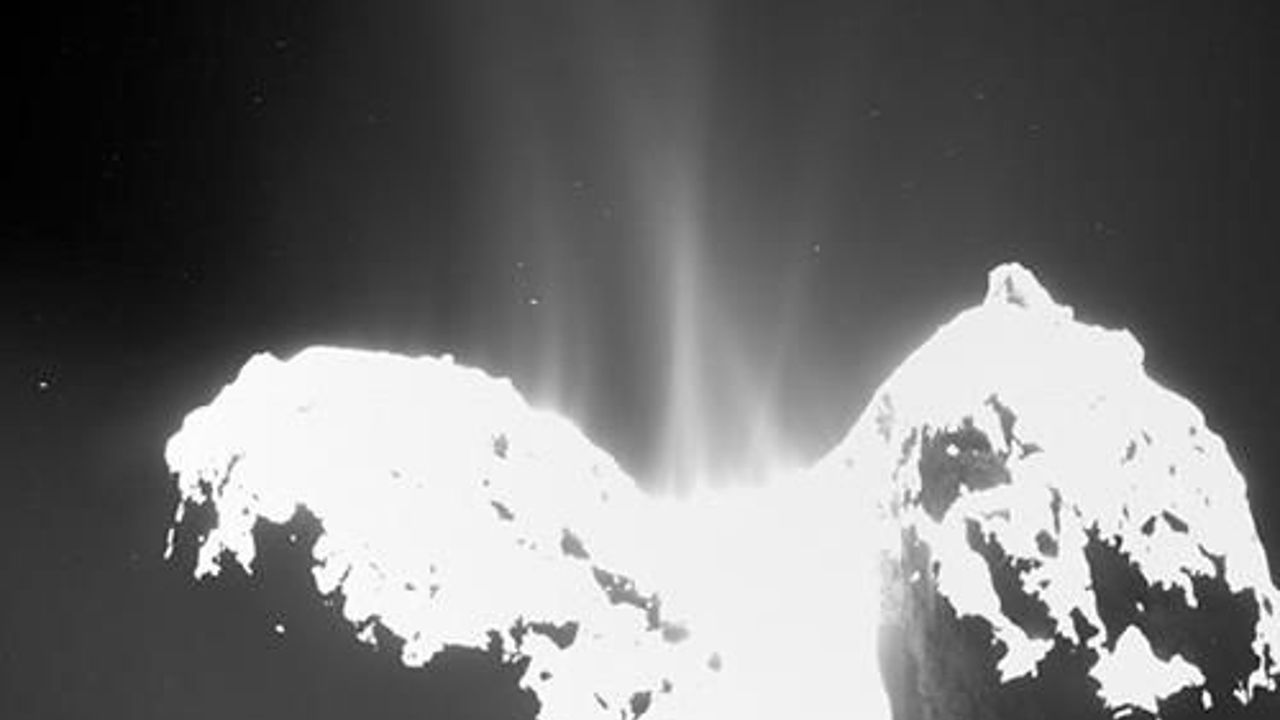Rosetta comet scrambles its jets, published by NASA
Science |
Images of the comet nucleus, taken by Rosetta earlier in the summer, showed that the distinct jets of dust and gas emanating from the comet were originated from the neck region, which connects the comet's two lobes. Images obtained by OSIRIS (Rosetta's Optical, Spectroscopic, and Infrared Remote Imaging System) now show jets of dust along almost the entire length of the comet.

Font Size:
Rosetta and comet 67P are still more than 280 million miles (450 million kilometers) from the sun. Based on a rich history of ground-based observations, scientists have been expecting the comet's activity to pick up noticeably once it comes within 186 million miles (300 million kilometers).
On Nov. 12, the Rosetta spacecraft will release its Philae lander at 3:03 a.m. EST / 1:03 a.m. PST (Earth Receive Time). Touchdown of Philae on Site J is expected about seven hours later, at around 11 a.m. EST / 8 a.m. PST. Rosetta is the first mission to attempt a soft landing on a comet.
While 67P's overall activity is clearly increasing, the mission's designated landing site, "J," located on the head of the comet, still seems to be rather quiet. However, there is some indication that new active areas are waking up about half a mile (one kilometer) from J. These will allow the lander's instruments to study the comet's activity from an even closer distance.
Launched in March 2004, Rosetta was reactivated in January 2014 after a record 957 days in hibernation. Composed of an orbiter and lander, Rosetta's objectives since arriving at comet 67P/Churyumov-Gerasimenko earlier this month have been to study the celestial object up close in unprecedented detail, prepare for landing a probe on the comet's nucleus in November and, following the landing, track the comet's changes as it sweeps past the sun.
Rosetta is a European Space Agency mission with contributions from its member states and NASA. Rosetta's Philae lander is provided by a consortium led by the German Aerospace Center, Cologne; Max Planck Institute for Solar System Research, Gottingen; National Center of Space Studies of France (CNES), Paris; and the Italian Space Agency, Rome. NASA's Jet Propulsion Laboratory in Pasadena, California, a division of the California Institute of Technology, manages the U.S. participation in the Rosetta mission for NASA's Science Mission Directorate in Washington.
Source: NASA
On Nov. 12, the Rosetta spacecraft will release its Philae lander at 3:03 a.m. EST / 1:03 a.m. PST (Earth Receive Time). Touchdown of Philae on Site J is expected about seven hours later, at around 11 a.m. EST / 8 a.m. PST. Rosetta is the first mission to attempt a soft landing on a comet.
While 67P's overall activity is clearly increasing, the mission's designated landing site, "J," located on the head of the comet, still seems to be rather quiet. However, there is some indication that new active areas are waking up about half a mile (one kilometer) from J. These will allow the lander's instruments to study the comet's activity from an even closer distance.
Launched in March 2004, Rosetta was reactivated in January 2014 after a record 957 days in hibernation. Composed of an orbiter and lander, Rosetta's objectives since arriving at comet 67P/Churyumov-Gerasimenko earlier this month have been to study the celestial object up close in unprecedented detail, prepare for landing a probe on the comet's nucleus in November and, following the landing, track the comet's changes as it sweeps past the sun.
Rosetta is a European Space Agency mission with contributions from its member states and NASA. Rosetta's Philae lander is provided by a consortium led by the German Aerospace Center, Cologne; Max Planck Institute for Solar System Research, Gottingen; National Center of Space Studies of France (CNES), Paris; and the Italian Space Agency, Rome. NASA's Jet Propulsion Laboratory in Pasadena, California, a division of the California Institute of Technology, manages the U.S. participation in the Rosetta mission for NASA's Science Mission Directorate in Washington.
Source: NASA
Video News

WORLD
26 Mart 2024 - 11:18
Photo News






